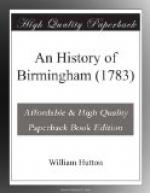Perhaps I shall not be charged with prolixity, that unpardonable sin against the reader, when it is considered, that three thousand years are deposited in the compass of one hundred and forty little pages.
Some other circumstances deserve attention, which could not be introduced without breaking the thread of history: But as that thread is now drawn to an end, I must, before I resume it, step back into the recesses of time, and slumber through the long ages of seventeen hundred years; if the active reader, therefore, has no inclination for a nod of that length, or, in simple phrase, no relish for antiquity, I advise him to pass over the five ensuing chapters.
IKENIELD STREET.
About five furlongs North of the Navigation Bridge, in Great Charles street, which is the boundary of the present buildings, runs the Ikenield-street; one of those famous pretorian roads which mark the Romans with conquest, and the Britons with slavery.
By that time a century had elapsed, from the first landing of Caesar in Britain the victorious Romans had carried their arms through the southern part of the isle. They therefore endeavoured to secure the conquered provinces by opening four roads, which should each rise in the shore, communicate with, and cross each other, form different angles, extend over the island several ways, and terminate in the opposite sea.
These are the Watling-street, which rises near Dover, and running North-west through London, Atherstone, and Shropshire, in the neighbourhood of Chester, ends in the Irish sea.
The Foss begins in Devonshlre, extends South-east through Leicestershire, continuing its course through Lincolnshire, to the verge of the German ocean.
These two roads, crossing each other at right angles, form a figure resembling the letter X, whose centre is the High Cross, which divides the counties of Warwick and Leicester.
The Ermine-street extends along the southern part of the island; near the British channel; and the Ikenield-street, which I cannot so soon quit, rises near Southampton, extends nearly North, through Winchester, Wallingford, and over the Isis, at New-bridge; thence to Burford, crossing the Foss at Stow in the Woulds, over Bitford-bridge, in the County of Warwick, to Alcester; by Studley, Ipsley, Beely, Wetherick-hill, Stutley-street; crosses the road from Birmingham to Bromsgrove, at Selley oak, leaving Harborne a mile to the left, also the Hales Owen road a mile West of Birmingham: Thence by the Observatory in Lady-wood-lane, where it enters the parish of Birmingham, crossing the Dudley road at the Sand-pits; along Worstone-lane; through the little pool, and Hockley-brook, where it quits the parish: Thence over Handsworth-heath, entering a little lane on the right of Bristle-lands-end, and over the river Tame, at Offord-mill, (Oldford-mill) directly to Sutton Coldfield. It passes the Ridgeway




